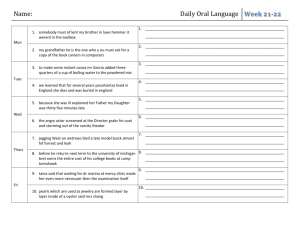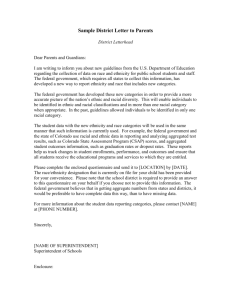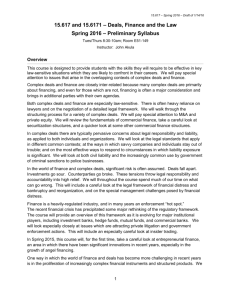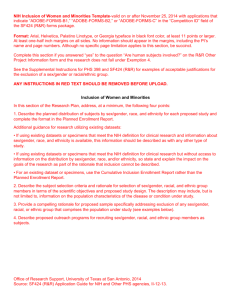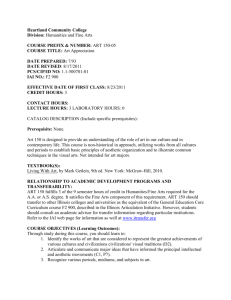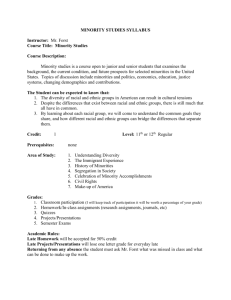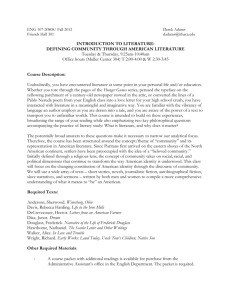Ethnic and Race Relations/Soc
advertisement
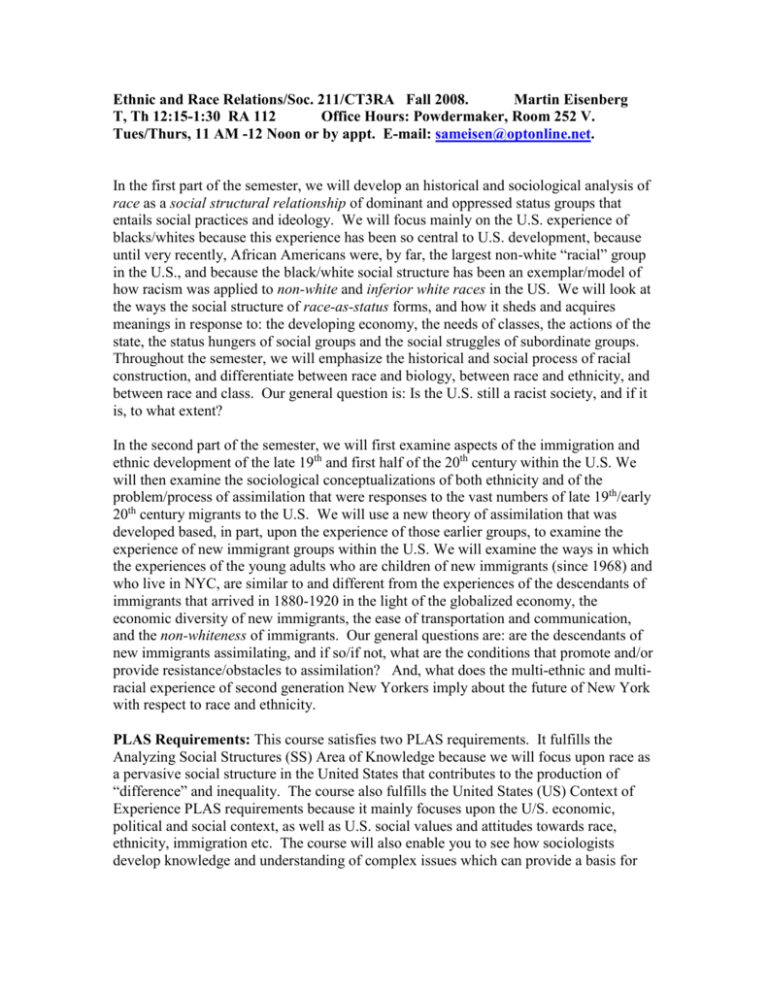
Ethnic and Race Relations/Soc. 211/CT3RA Fall 2008. Martin Eisenberg T, Th 12:15-1:30 RA 112 Office Hours: Powdermaker, Room 252 V. Tues/Thurs, 11 AM -12 Noon or by appt. E-mail: sameisen@optonline.net. In the first part of the semester, we will develop an historical and sociological analysis of race as a social structural relationship of dominant and oppressed status groups that entails social practices and ideology. We will focus mainly on the U.S. experience of blacks/whites because this experience has been so central to U.S. development, because until very recently, African Americans were, by far, the largest non-white “racial” group in the U.S., and because the black/white social structure has been an exemplar/model of how racism was applied to non-white and inferior white races in the US. We will look at the ways the social structure of race-as-status forms, and how it sheds and acquires meanings in response to: the developing economy, the needs of classes, the actions of the state, the status hungers of social groups and the social struggles of subordinate groups. Throughout the semester, we will emphasize the historical and social process of racial construction, and differentiate between race and biology, between race and ethnicity, and between race and class. Our general question is: Is the U.S. still a racist society, and if it is, to what extent? In the second part of the semester, we will first examine aspects of the immigration and ethnic development of the late 19th and first half of the 20th century within the U.S. We will then examine the sociological conceptualizations of both ethnicity and of the problem/process of assimilation that were responses to the vast numbers of late 19th/early 20th century migrants to the U.S. We will use a new theory of assimilation that was developed based, in part, upon the experience of those earlier groups, to examine the experience of new immigrant groups within the U.S. We will examine the ways in which the experiences of the young adults who are children of new immigrants (since 1968) and who live in NYC, are similar to and different from the experiences of the descendants of immigrants that arrived in 1880-1920 in the light of the globalized economy, the economic diversity of new immigrants, the ease of transportation and communication, and the non-whiteness of immigrants. Our general questions are: are the descendants of new immigrants assimilating, and if so/if not, what are the conditions that promote and/or provide resistance/obstacles to assimilation? And, what does the multi-ethnic and multiracial experience of second generation New Yorkers imply about the future of New York with respect to race and ethnicity. PLAS Requirements: This course satisfies two PLAS requirements. It fulfills the Analyzing Social Structures (SS) Area of Knowledge because we will focus upon race as a pervasive social structure in the United States that contributes to the production of “difference” and inequality. The course also fulfills the United States (US) Context of Experience PLAS requirements because it mainly focuses upon the U/S. economic, political and social context, as well as U.S. social values and attitudes towards race, ethnicity, immigration etc. The course will also enable you to see how sociologists develop knowledge and understanding of complex issues which can provide a basis for political decisions and social policies that have important consequences for society at large. Course Objectives: 1) To practice and improve reading and writing skills. 2) To acquire an understanding that the intergroup race relationship, practice and ideology is socially constructed over time, and that race is not based in biology or ethnicity or class. 3) To acquire a basic knowledge of the theories and concepts used to analyze race including, for example, caste, status, racial structuring, racialization, enclaves, ghettos, segregation, discrimination. 4) To acquire a basic knowledge of the theories and concepts used to analyze ethnicity including, for example, immigration, ethnic enclaves, transnationalism, assimilation, multiculturalism. Absences and Lateness: Understanding the readings and contributing to class discussion are necessary in order to learn the material and do well in class. Please do not be absent. Also, I handle class business during the first five minutes of class and lateness distracts me and distracts the class. If you are late, please be certain to inform me of your presence at the end of class so I can mark you present. And please be sure to find out what was discussed in the first five minutes. Please do not be late. Grades: I calculate your grade as follows: three non-cumulative tests (16 points each) equal 48 points; two papers (21 points each) equal 42 points; group reports are 5 points; and, participation represents 5 points towards your grade. PLEASE NOTE that if you do not participate or you do not contribute to your group report, you will not get any points. Everyone starts at zero for participation and points have to be earned. Please bring a #2 pencil for all exams. All exams are multiple-choice and true/false tests with some short answer questions that deal with the central points of the reading. If you have done the readings on time, been attentive to the issues emphasized in class, participated in class, and taken careful notes, you will find the tests relatively easy. Participation: Questions, comments, disagreements and reactions to the readings or to what is said by the instructor or students are welcomed. I assume that there are absolutely no “dumb” questions when someone wants to know something. All of us have thought about and had considerable experience with race and ethnicity. Our learning will be richer to the extent that we share our ideas and experiences with others in the class and to the extent that we bring our understandings to bear upon the readings in the course. I expect and require that students will do the assigned readings on time and arrive in class ready to discuss what they have read. Papers and Group Reports are discussed at the end of this syllabus. Thur Aug 28. Introduction: Aims of this course. What’s the difference between ethnicity and race, and between biology and race? Race is a social, political and historical construction of a practice and set of meanings? Tues Sept 2. Race is a Biological Fiction. Read: “Statement of the American Anthropological Association” – why were race and racism invented? Watch video: “Race: the Power of an Illusion”. Thurs Sept 4. Race As a Social Reality. Ojito (NY Times), “Best of Friends, Worlds Apart in America: Cuban Friends Discover Race Matters”. Race is the practice of a socially structured relationship, not a thing. Race trumps ethnicity. Tues Sept 9. Inventing Race and Racism In Order to Defend Slavery. Smedley, “The Social Origins of Race”. Which comes first, prejudice or slavery? Why is slavery important in North America and why are African slaves chosen and imported as slaves by the millions? What is the significance of Bacon’s Rebellion? What are the three ideological justifications of slavery? What does Smedley mean by “Race”? When does the concept develop and why? Thurs Sept 11. More on Race in the U.S.: the Development of Caste and the Invention and Maintenance of Jim Crow Subordination. DuBois, “Back Toward Slavery” from Black Reconstruction (1935). Pp. 670-708. After the Civil War in the U.S., what are the needs of plantation owners, white labor and black labor, as these categories of people perceive their needs? Who gets what they want and how? What is the “public and psychological wage” and who gets it? What is Caste and what does it take to establish and maintain it? Tues Sept 16. The Conceptualization of Race and Racism as Sociological Phenomena of Power, Conflict, Social Structural Domination/Subordination Combined With a Reference to a Fictional Biological Difference. Max Weber on “Status”, pp. 1, 4-8. Read the sections on “Power”, skip the sections on “Class”, and Read the Sections on Status. What is status and what is a status group? Who initiates the formation of status groups and why? What is the basis of status, and how is status expressed? How does the societal attribution of negative social honor to a group, exclude the group’s members from economic and political opportunity? What does “caste” mean and what is the difference between status and caste? What is the difference between status and ethnicity? Thurs Sept 18. Inferior White Races of lesser status than native whites. Guglielmo, “No Color Barrier: Italians, Race and Power in the U.S.”. What is the difference in the experience of Italian immigrants and their second generation, and the experience of African Americans? Steinberg, “The Jewish Horatio Alger Story”. Who is Horatio Alger, and why this title? What factors enable the Jews to succeed so rapidly: is it their middle class culture, ambition and commitment to education, or is it their human capital, or the time and location of their arrival? Tues Sept 23. The Significance of the State for Social Mobility. Brodkin, “How the Jews Became White Folks”. What does “white folks” mean in the title of the article? In what sense is the implementation of the G I Bill after WW II an affirmative action program for whites: in education, employment and housing? What is the impact of World War II on the civil rights of Euro-ethnics and African Americans? Thurs Sept 25. The Significance of Social Struggle For an End to Caste. Morris and Herring, “The Civil Rights Movement”. Omi and Winant, “The Great Transformation” What are the necessary conditions of the Civil Rights movement? How does the Civil Rights movement expand politics and redefine black identity? What was Black Power? What was “entrism”, “socialism” and “nationalism”? Tues Sept 30. No classes scheduled. Thurs Oct 2. Summarizing the Difference in the Historical Experience of White Euro-Ethnics and African Americans: Voluntary/Involuntary migration; manufacturing/agriculture; urban/rural; politics/disenfranchisement; maintaining culture/relinquishing and new constructions of culture; prejudice/caste. Review for Test #1. The test covers the period from the beginning of the semester through Oct 2. Tues Oct 7. TEST # 1 Bring a #2 Pencil. After the test, we will review the answers. Thurs Oct 9. No classes scheduled. Tues Oct 14. Classes follow a Monday schedule. Thurs Oct 16. Inequality of Wealth. Dalton Conley, An interview on the racially unequal accumulation of wealth. How do most people accumulate wealth and why is the possession of wealth so important? Dymski and Mason, pp. 151-156, “Racial Inequality and African Americans’ Disadvantage in the Credit and Capital Markets”. Shapiro and Kenty-Dane, pp. 175-181, “The Racial Wealth Gap”. Tues Oct 21. Housing and Residential Segregation and the Veil. Massey, “Residential Segregation and Neighborhood Conditions in U.S. Metropolitan Areas” What processes promote residential racial segregation and how is segregation measured? “The Downward Spiral”(in the course pack after Conley). Are blacks to blame for the fact that the value of homes in white areas increase faster or decrease in contrast to interracial or black areas? Thurs Oct 23. The Veil and Racial Discrimination in the Labor Market. American Sociological Association, pp. 1-10, “Race, Ethnicity and the American Labor Market” Patrick L. Mason, pp. 141-150, “Persistent Racial Discrimination in the Labor Market” Tues Oct 28. Other Aspects of the Racial Present. Google: Population Reference Bureau: < “New Marriages, New Families: U.S. Racial and Hispanic Intermarriage”>. Read, pp. 4,5, 11-16, 29-32. D. Muhammad, “The Unrealized American Dream”. The Ideological Ways of Whiteness. Bonilla-Silva, “The Central Framework of Color-Blind Racism” What is an ideology? What does Bonilla-Silva mean by a “frame”? What do the frames, “abstract liberalism”, “naturalization”, “cultural racism”, and “minimization of racism” mean? Thurs Oct 30. The Political Ways of Whiteness Whites Unawareness of Whiteness P. McIntosh, “White Privilege: Unpacking the Invisible Knapsack”. White Race Projects Winant, “Behind Blue Eyes: Whiteness and Contemporary U.S. Politics”. What is “racial dualism”, “race projects”, “race formation”? What are the major race projects of whites in the U.S.? DuBois, “Double Consciousness and the Veil”. What is the veil? What is doubleconsciiousness? How is the veil related to housing discrimination? Tues Nov 4. Assimilation Theory Early assimilation theory: Eisenberg, “Sociological Reflections on the Melting Pot, Cultural Pluralism, and Assimilation” What do those terms mean? What are social indicators? What is the criticism of Park’s theory? Alba and Nee, “New Assimilation Theory: The Conceptual Framework”. Purposive action, forms of capital, social network mechanisms, and institutional mechanisms. How should we use Park and Alba and Nee to analyze the articles on the 2nd Generation. Thurs Nov 6. Paper #1 is due. The Economic Function of Immigration. Eisenberg, “Rules of Capitalism” Review for Exam # 2 Groups meet briefly to prepare for Group Presentations. Tues Nov 11. EXAM #2. Bring a #2 pencil. After the exam we will review the answers. Thurs Nov 13. Evidence of Contemporary Assimilation: How Shall We Use Park and Alba and Nee to Assess the Assimilation Process. Alba and Nee, pp. 217-248, 260—270. “Evidence of Contemporary Assimilation” Tues Nov 18 -Thurs Nov 20. Dominican-Americans and Other Latinos/Latinas - Americans. Marwell, “Ethnic and Post-Ethnic Politics in New York City: The Dominican Second Generation”. Other Readings on Latinos to be announced. Tues Nov 25. Black West Indian – Americans in NYC. Vickerman, “Jamaicans: Balancing Race and Ethnicity”. Butterfield, “ ‘We’re Just Black’: The Racial and Ethnic Identities of Second-Generation West-Indians in New York.” Thurs Nov 27. Thanksgiving. College closed. Tues Dec 2. More on 2nd Black West Indians in NYC. Forester, “ ‘Isn’t Anybody Here From Alabama,’: Solidarity and Struggle in a ‘Mighty, Mighty Union’ ”. Thurs Dec 4- Tues Dec 9. Korean Americans: Immigrants and the Second Generation. Pyong Gap Minh “Korean Americans” Lee, “Class Matters: Racial and Ethnic Identities of Working- and Middle-Class SecondGeneration Korean Americans in NYC”. Kibria, “Becoming Asian American” Thurs Dec 11. Paper #2 is due for Latino and Black West Indian Groups. The Future of Race in the U.S. E. Bonilla-Silva and D.G. Embrick, “Black, Honorary White, White: The Future of Race in the U.S.” G. Yancy, “Racial Justice in a Black/Nonblack Society” Tues Dec 16. Paper #2 is due for Korean groups. “I’m here to get a degree in a subject that prepares me to get a decent job. Why do I have to bother with this stuff?” Review for Exam #3 Final Exam Instructions For Writing Paper: Do NOT wait until the weekend before either paper is due to read the following instructions. If it is two weeks before the paper is due and you still do not understand how you should think about or write either one of these papers, you must come to see me and discuss the paper with me. Goals of these paper assignments: 1) To think more deeply about and to demonstrate your understanding of the concepts and theories we have read about and discussed in class. 2) To demonstrate your ability to use the concepts, theories and empirical evidence we have discussed to synthesize and organize a coherent argument based on the given readings. Free Admonitions: This paper is your opportunity to demonstrate your ability to reflect upon and use the readings to address the assigned question or problem. You are not being asked merely to summarize a single reading or group of readings. Your paper should use as much of the relevant material in the assigned readings as you can to make your argument. This paper does not require research beyond the assigned readings. In fact, although I encourage you to read widely about the topics we are discussing, you need not refer to outside readings in your papers. In particular, be very careful about using the dictionary or Wikkipedia or any other encyclopedia to define terms that we have explored and discussed in class. There are two reasons for this. First, those sources will not use the terms we have discussed the way we have defined them in class. Second, if you do use terms as they are used in a dictionary, make certain to point out the contradictions between how we have used the terms and how other sources use these terms. The same is true for any material you use from the internet. Technical Matters: Double-space the paper. Your margins should be one inch at the top and bottom and 1.25” on the left and right. Your type size should be 12 points; your font should be Times New Roman. Save a tree, do not attach a separate title page. Research and Plagiarism. If you use and author’s ideas, or you quote from an author, you must insert the author’s name, and the page numbers where the idea or quote can be found in parentheses within the text of your paper, mostly at the end of the sentences (e.g., Eisenberg 6). If you do that, it is called research and is applauded. On the other hand, if you use an author’s ideas or words and don’t quote or cite the author, that is called plagiarism. Plagiarism is cheating and unacceptable. Research is better. Also if you do not cite where your theories, ideas and data are coming from, you are not doing the assignment. Do not attach a list of references unless you are using material not included on the syllabus. If you mention the authors’ names and page number, I will know the source. Paper# 1: This is a five – six (no more) page paper. This paper should FOCUS on the period since the end of the Civil Rights Movement. You may refer to the past if you need to but do not spend more than one page on the period before the CRM. African Americans are an ethnic group as we have defined that term in this course. They have also been a subordinated/oppressed status group, dominated by whites, at least for most of the period since the end of slavery. Many people currently argue that racism is over and that we live in a color-blind society. THE QUESTION YOU ARE ASKED TO ANSWER IN THIS PAPER IS: Do whites still exercise domination over African Americans by treating them and other Blacks as a subordinated status group? By a subordinated status group, I mean what Weber and DuBois mean. Think about the meaning of this term in the present and how it is expressed. Remember: the existence of racial disparities with regard to income, wealth, health care, occupations, education, poverty, etc., may suggest, but do not prove that racial subordination continues to exist. If all you do is cite these disparities, you have written an inadequate paper. You need to show and theoretically argue that these disparities are a consequence of on-going status processes (the attribution of negative social honor, i.e., prejudice and the practice of discrimination based on prejudice) in housing, the labor market and wherever else) or unchanging inequities of the past that enact and perpetuate the unequal distribution of social, economic and political opportunities. Or, you need to show and/or theoretically argue that despite existing disparities that are legacies of the past, and aside from individual instances of discrimination, racism is over, brighter days are ahead because we live in a color-blind society. Do not merely summarize the assigned readings. MAKE AN ARGUMENT. Take a position and defend your position against the opposite side. Imagine what the other side would argue and show why it is wrong. And your side is right. Or, if you are uncertain as to what your position ought to be, write a paper showing the reasoning of both sides, Paper # 2. This paper should be no more than 5 pages. THE TWO QUESTIONS YOU ARE ASKED TO ANSWER IN THIS PAPER ARE: 1) Is the ethnic group you have chosen to examine from among the “second generation of the new immigration” assimilating, resisting assimilation, or both? Make an argument for what you believe. And, 2) What do you believe is the future for this group (say in 25 years) in relation to the process of assimilation? (You cannot answer this question without a theory of ethnicity and ethnic change in addition to empirical evidence.) Use all the theoretically and empirically relevant material assigned in this course about the group you have chosen, not just the article you reported on, and not just the articles that deal explicitly with your group. Do not merely summarize all the articles about your groups. This is an analytical paper. The answers to the questions are not obvious. If you write this paper without using Park and/or Alba and Nee to think beyond what is presented in the readings, your paper will not be as strong as it could be. Group Presentations: Everyone is assigned to read all of the readings about each of the ethnic groups. But, the presentation group has additional responsibilities. The responsibility of the “presentation group” is to present the basic ideas in the reading and to lead the class in the responses to the questions I will pose (before the day of presentation), and to present the questions the group has about the readings, given the theoretical reading that we have done. Every one in the presentation groups should be able to answer any of the questions that I or anyone in the class pose or to explain the questions you have which make the question difficult to answer. The presentations are worth two of the five points of participation. Each person in the group should speak. If you are not able to participate in discussions with your assigned group in preparation for the presentation, you should not participate in the presentation. In that case, see me and I will try (no guarantees) to assign you to a group that meets at a time convenient for you. Each group should make time to meet twice: once, to discuss the reading and to generally answer the two questions below and also to assign what each student will present. (That means you must have read the article beforehand.); and , the second time to read to one another what you have written up in order to help one another sharpen up your responses. I will try toi make time for at least one of these meetings in class. The group should answer two questions: 1) What are the central ideas of the author? And. 2) What is the evidence in the reading that the group is assimilating or resisting assimilation? In your answers, refer to theories we have discussed to analyze the article.
